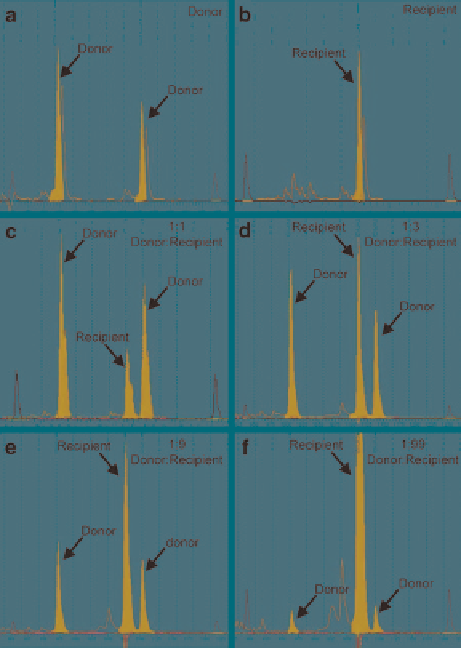Biomedical Engineering Reference
In-Depth Information
can reliably detect donor chimerism in recipient ejaculates at levels of 1-5% and was
used recently to detect donor sperm production in SSC-transplanted dogs (Kim et al.
2008
). Pilot studies using rhesus macaque sperm have demonstrated that we can
detect at least 1% donor chimerism in mixed samples of ejaculated sperm using
microsatellite fingerprinting (Fig.
11.4
). Alternatively, HLA allotyping PCRs are able
Fig. 11.4
Assessing transplanted SSC engraftment in allogeneic recipients by DNA microsatellite
fingerprinting. Allogeneic rhesus-to-rhesus SSC transplants performed between unrelated indi-
viduals may offer the benefit of maximizing the detection of donor-derived spermatogenesis in
recipient testes. If donor SSCs are tolerated by the recipient immune system, engraft, and produce
sperm that are present in the ejaculate, it is possible to take advantage of the genetic differences
between donor and recipient to definitively determine the presence of donor spermatogenesis. To
demonstrate this phenomenon, sperm from two unrelated animals (putative donor and recipient)
were genotyped at Veterinary Genetics Laboratory at the University of California at Davis. (
a
) The
“donor” animal possesses the 212bp and 232bp alleles of microsatellite locus D13S765, while
(
b
) the “recipient” animal possesses the 228bp allele of D13S765. Mixtures of sperm from the
donor and recipient animals at defined ratios of (
c
) 1:1 donor:recipient (50% donor), (
d
) 1:3
donor:recipient (25% donor), (
e
) 1:9 donor:recipient (10% donor), (
f
) 1:99 donor:recipient
(1% donor) were used to extract DNA for microsatellite fingerprinting to determine the threshold
to detect donor chimerism. We found that we could detect as low as 1% donor chimerism.
Therefore, microsatellite fingerprinting of ejaculated sperm could provide a sensitive, noninvasive
method for detecting donor spermatogenesis in allogeneic transplant recipients

Search WWH ::

Custom Search